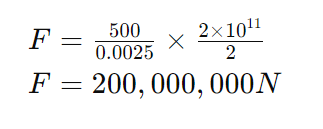Rod Bending Force Calculator
Introduction
Calculating the bending force on a rod is essential in various engineering and construction applications. Whether designing structures or analyzing materials, understanding this force is crucial. To simplify this process, a rod bending force calculator can be incredibly handy. In this article, we’ll discuss how to use such a calculator effectively, the underlying formula, provide an example solve, address common questions, and conclude with the significance of this tool.
How to Use
Using the rod bending force calculator is straightforward. Simply input the necessary parameters such as the modulus of elasticity, moment of inertia, length of the rod, and the applied load. Then, click the “Calculate” button to obtain the bending force result.
Formula
The formula to calculate the bending force (F) on a rod is:

Where:
- F = Bending force (N)
- M = Applied moment (Nm)
- I = Moment of inertia (m^4)
- E = Modulus of elasticity (Pa)
- L = Length of the rod (m)
Example Solve
Let’s consider a rod with the following parameters:
- Applied moment (M): 500 Nm
- Moment of inertia (I): 0.0025 m^4
- Modulus of elasticity (E): 200 GPa (2 × 10^11 Pa)
- Length of the rod (L): 2 m
Plugging these values into the formula, we get:

FAQs
Q: What is the modulus of elasticity?
A: The modulus of elasticity, often denoted as E, represents a material’s stiffness or resistance to deformation under stress.
Q: Why is calculating bending force important?
A: Understanding bending force helps engineers ensure the structural integrity of materials and design components that can withstand applied loads.
Q: Can this calculator be used for different materials?
A: Yes, as long as the appropriate material properties are provided, this calculator can be used for various materials like steel, aluminum, or wood.
Conclusion
A rod bending force calculator simplifies the complex task of determining the bending force on a rod. By inputting relevant parameters, engineers and designers can quickly obtain accurate results, aiding in the efficient and effective analysis of structural components. With its simplicity and accuracy, this tool proves invaluable in numerous engineering applications.
